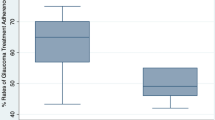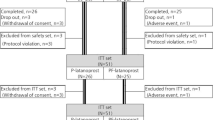Abstract
Aims and purpose
To identify patterns and rates of adherence with travoprost eye drops using the Travatan dosing aid (TDA) and to present a method for graphically presenting adherence data.
Methods
A prospective observational cohort study of patients on travoprost (prostaglandin) monotherapy. Patients were dispensed a TDA and followed up after approximately 3 months of usage. Data were downloaded from the TDA into a computer for analysis. Analysis used inter-dose intervals (the time between each dosing) to look at adherence between days 4 and 75.
Results
In all, 100 patients were invited to participate, 53 agreed and complete TDA data sets were obtained from 37. In total 23 of the complete data sets showed good adherence (dosing within ±4 h of the agreed dosing time on >80% of occasions), 3 patients discontinued usage before 75 days, 4 showed frequent drug holidays (no dosing for ⩾8 days) and 7 frequently missed doses with adherence rates of <60%. Of the 16 patients for whom no TDA data was obtained, 5 were lost to follow-up, 4 had faulty/damaged TDAs, 3 changed medication, 3 preferred not to use the TDA, and 1 was hospitalized.
Conclusions
There were four easily defined patterns of adherence; (1) good adherence; (2) discontinued usage; (3) frequent drug holidays; and (4) frequent missed doses with low adherence rates. A new method for graphically presenting adherence data helps clinicians identify the pattern of usage and is a valuable aid to the overall management of patients on travoprost therapy.
Similar content being viewed by others
Log in or create a free account to read this content
Gain free access to this article, as well as selected content from this journal and more on nature.com
or
References
Cramer JA, Roy A, Burrell A, Fairchild CJ, Fuldeore MJ, Ollendorf DA et al. Medication compliance and persistence: terminology and definitions. Value Health 2008; 11: 44–47.
Kass MA, Meltzer DW, Gordon M, Cooper D, Goldberg J . Compliance with topical pilocarpine treatment. Am J Ophthalmol 1986; 101: 515–523.
Kass MA, Gordon M, Meltzer DW . Can ophthalmologists correctly identify patients defaulting from pilocarpine therapy? Am J Ophthalmol 1986; 101: 524–530.
Olthoff CM, Schouten JS, van de Borne BW, Webers CA . Noncompliance with ocular hypotensive treatment in patients with glaucoma or ocular hypertension: an evidence-based review. Ophthalmology 2005; 112: 953–961.
Farmer KC . Methods for measuring and monitoring medication regimen adherence in clinical trials and clinical practice. Clin Ther 1999; 21: 1074–1090.
Cronin TH, Kahook MY, Lathrop KL, Noecker RJ . Accuracy and performance of a commercially available dosing aid. Br J Ophthalmol 2007; 91: 497–499.
Boden C, Sit A, Weinreb RN . Accuracy of an electronic monitoring and reminder device for use with travoprost eye drops. J Glaucoma 2006; 15: 30–34.
Friedman DS, Jampel HD, Congdon NG, Miller R, Quigley HA . The TRAVATAN dosing aid accurately records when drops are taken. Am J Ophthalmol 2007; 143: 699–701.
Friedman DS, Okeke CO, Jampel HD, Ying GS, Plyler RJ, Jiang Y et al. Factors for poor adherence to eyedrops in electronically monitored patients with glaucoma. Ophthalmology 2009; 116: 1097–1105.
Okeke CO, Quigley HA, Jampel HD, Ying GS, Plyler RJ, Jiang Y et al. Adherence with topical glaucoma medication monitored electronically. The Travatan Dosing Aid Study. Ophthalmology 2009; 116: 191–199.
Stein JD, Ayyagari P, Sloan FA, Lee PP . Rates of glaucoma medication utilization among persons with primary open-angle glaucoma, 1992–2002. Ophthalmology 2008; 115: 1315–1319.
De Amici D, Klersy C, Ramajoli F, Brustia L, Politi P . Impact of the Hawthorne effect in a longitudinal clinical study: the case of anesthesia. Control Clin Trials 2000; 21: 103–114.
Robin AL, Novack GD, Covert DW, Crockett RS, Marcic TS . Adherence in glaucoma: objective measurements of once-daily and adjunctive medication use. Am J Ophthalmol 2007; 144: 533–540.
Acknowledgements
We thank Alcon for generously providing the Travatan Dosing Aids. This study was supported by the Manchester Academic Health Sciences Centre (MAHSC) and the NIHR Manchester Biomedical Research Centre.
Author information
Authors and Affiliations
Corresponding author
Ethics declarations
Competing interests
The authors declare no conflict of interest.
Rights and permissions
About this article
Cite this article
Ajit, R., Fenerty, C. & Henson, D. Patterns and rate of adherence to glaucoma therapy using an electronic dosing aid. Eye 24, 1338–1343 (2010). https://doi.org/10.1038/eye.2010.27
Received:
Revised:
Accepted:
Published:
Issue date:
DOI: https://doi.org/10.1038/eye.2010.27
Keywords
This article is cited by
-
Factors affecting medication adherence among older adults using tele-pharmacy services: a scoping review
Archives of Public Health (2022)
-
Personalized behavior change program for glaucoma patients with poor adherence: a pilot interventional cohort study with a pre-post design
Pilot and Feasibility Studies (2018)
-
Improving adherence to glaucoma medication: a randomised controlled trial of a patient-centred intervention (The Norwich Adherence Glaucoma Study)
BMC Ophthalmology (2014)
-
Patterns of adherence behaviour for patients with glaucoma
Eye (2013)
-
Lazy Sunday afternoons: the negative impact of interruptions in patients’ daily routine on adherence to oral antidiabetic medication. A multilevel analysis of electronic monitoring data
European Journal of Clinical Pharmacology (2013)



